On a whitewashed church pew in Johnson City, I sat alone as James Eaton stood over me delivering a sermon. It was a Monday, and this was Eaton’s office. One of the inventors of payday lending—the business of making small, short-term loans from retail locations at steep rates—Eaton operates out of a converted service station, with a tarp sign in red and white: here’s where it all started. east tennes see’s first, oldest & finest. He had suggested we conduct our interview in his reception area, on the pew he brought up years ago from…
Sign in to access Harper’s Magazine
We've recently updated our website to make signing in easier and more secure
Sign in to Harper's
Hi there.
You have
1
free
article
this month.
Connect to your subscription or subscribe for full access
You've reached your free article limit for this
month.
Connect to your subscription or subscribe for full access
Thanks for being a subscriber!
Get Access to Print and Digital for
$23.99 per year.
Subscribe for Full Access
Subscribe for Full Access







































































































